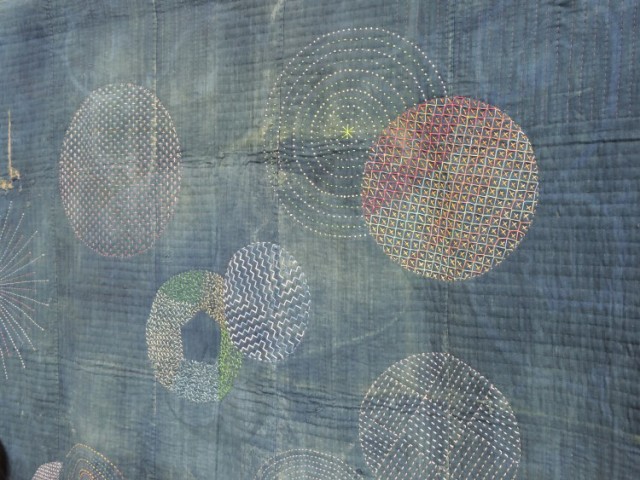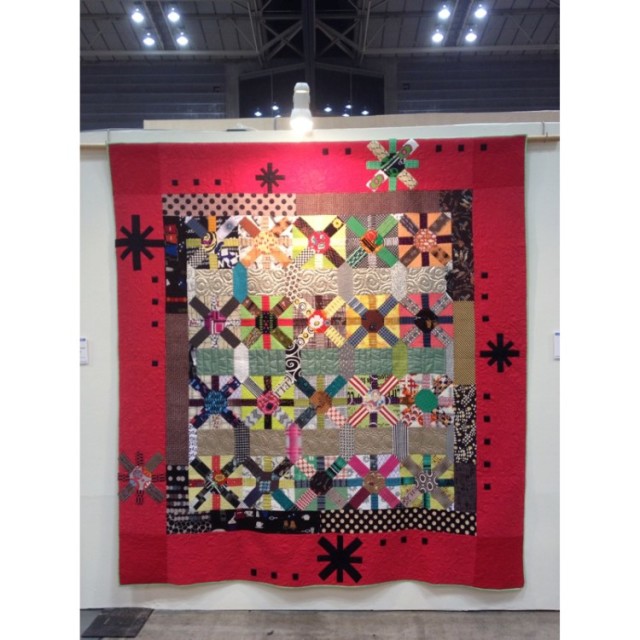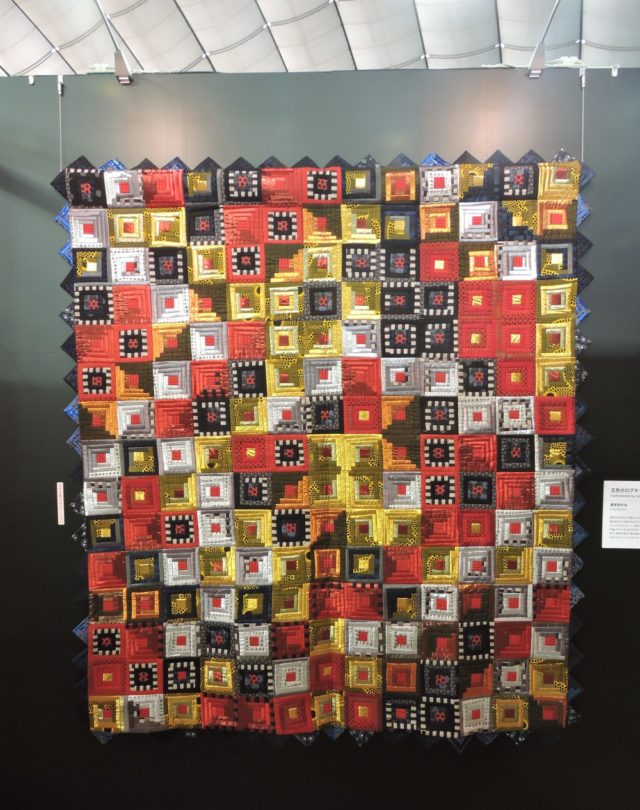A year ago yesterday, we moved back to Australia. I thought it fitting to share an article I wrote for Make Modern (issue 13) about comparing Japanese quilting to Australian quilting.
Having just spent four years living and quilting in Japan, I’m often asked how Japanese quilting differs from the rest of the world. It’s hard to say definitively, but there are a few points that can be made from my experiences at various quilt shows in Japan, where one presumes that the best of the best is shown. But these points also pervade the shopping there – the way sewing is marketed, the handmade items I saw in daily life.
Handwork
There is a big focus on hand work – hand piecing and hand quilting feature very heavily in the quilt shows I’ve visited. This is due in part to the history of sewing in Japan with the classic sashiko and other embroidery styles employed in Japanese sewing. Whether it was on a beautiful kimono, or practically used to create warm clothes by adding layers and heavy stitching, hand sewing is ingrained in Japanese culture. From a practical standpoint, many quilters may simply not have the space to set up the table space needed to machine quilt at home. Related – long arm quilting certainly hasn’t taken off in Japan either, presumably for the same reasons!

Thrifty
Japan is a very resourceful country. Having to eke out an existence for 100+ million people on a tiny land mass means that the Japanese people have become very thrifty, with tricks to make most out of any space, and also a rather complicated system of waste disposal. Just ask anyone who has visited Japan and tried to find a bin while out and about! This need for thrifty is reflected in Japanese quilting, where it relatively rare to find a quilt that hasn’t been made from scraps and/or many different, small, pieces of fabric. Whether intentionally scrappy, or thrifty buying of small selections of fabric, there is a sharp contrast between more “cohesive” quilts with the same line or style of fabric (such as solids), and those that are a glorious riot of colour and prints. Even the more traditional Japanese style of quilts that use indigo fabrics will include a range of different shades and textures within the quilt.

Improvisational
Related to the scrappy fabrics, is the high rate of improv-style quilts. As someone who prefers geometric, ordered quilt designs, this is something I’ve especially noticed. Even a simple background section may be made of multiple small pieces sewn together in an improvisational type manner. Similarly, they are not afraid of partial or Y-seams. This may play back into the high use of hand piecing, which makes it easier to make those kind of seams.
Materials and more
Japanese quilters are also not afraid of including different textiles and bling in their quilts. Yoshiko Jinzenji’s style of silhouette quilts is one such example, where she often uses a shiny metallic fabric as the base for her quilt top upon which she places cut out pieces, which is then topped by a sheer, netted fabric and quilted in place. I’ve also seen quilts with what can only be described as a piping edge instead of binding. Applique quilts may include a range of different textiles to create the shapes, and beads or sequins or other similar types of materials are not uncommon either.

Everyday life
But how do these quilt show masterpieces compare to what I saw every other day of the year? I saw many tiny, hand-pieced quilt blocks turned into hand bags, or more simply-pieced bags covered in sashiko. I made many different bags for my kids and friends’ kids for Japanese preschool, and those that didn’t make their own or buy from a handmade business, bought bags that still looked like handmade from the store. Handmade is highly valued, and sewing is still a big part of everyday life, as evidenced by a craft store being included in every mall built by huge department store chain, big or small. Can you imagine being able to get your groceries, a new pair of socks, and some quality fabric or thread, in one stop? And no one ever blinked or gave a puzzled look when I told them I quilted and sewed.
Quilting In Australia
Having just attended my first Australian quilt show, as well as having attended a symposium on the history of quilting in Australia, I can see the subtle and not-so-subtle differences in quilting between the two countries. Quilting in Australia was not born, or continued, out of necessity to keep warm. Our winters are a lot milder than those in the northern hemisphere! But rather, the tradition continued as a way of providing a decorative touch to homes, or as a family heirloom to record the story and life of the maker. As quilters tended to have a lot more space in their houses too, many quilts were large and pieced as a whole-picture, rather than block by block.
Which continues to this day, but many are pieced and quilted by machine instead. Our quilts tend to feature larger pieces of fabric, and only use quilting cotton fabric at that. But that’s where the main differences in our quilting stop. Because many Australian quilters do make improv quilts. And scrappy quilts. And hand-pieced and/or hand-quilted quilts. While it may be fair to point out that most quilts at shows are machine-pieced and made with incredible precision and points compared to the scrappy, improv masterpieces of Japan, there is still a wide range of quilting styles present in the much-smaller quilting population of Australia.
Everyday life
Gone are the one-stop shopping trips for supplies, and the cheap prices for top quality quilting cottons! Back are the puzzled looks when I respond to, “What do you do?” with the answer, “I’m a quilter”. Gone are the everyday glimpses of handmade items everywhere. But back are the readily-found quilting and sewing groups, with many more quilters and groups using the internet to share information and details of classes and sewing days. Australia has embraced the online world of quilting, through blogs, websites, and online shopping, something in which Japan has yet to really find its footing.
Both countries have some clear differences in style and methods, and prices of supplies! Yet one thing is clearly the same – we love quilting for the love of making and creating. That speaks through all of our work, whether it be improv or precise, bright or dark, big or small. And if we were all the same, life would be so boring!


margiestitcher says
such an interesting blog, I saw lots f photos of the Tokyo quilt show as I blog with a quilter in Japan, the quilts were amazing. Last time in Australia I went to a quilt show they were nearly all pictorial quilts also amazing
Alyce says
Yes, there do tend to be a lot more “art” pictorial quilts here, I have noticed that in the months since I first wrote this!
Teje says
Thank you Alyce for an interesting and lovely post! x Teje
Alyce says
My pleasure, Teje!
MJ Snyder says
Alyce:
Terrific information. Love your perspective and ability to communicate.
Thanks for doing what you do!
Happy quilting…
MJ
Alyce says
Thank you so much, MJ!
Cocopatch says
very interesting ! Thank you Alyce!
Alyce says
You’re very welcome!
Summer says
I now have new insight into the quilts I see from Japanese quilters every year at IQF in Houston.
Alyce says
Glad to be of assistance! 🙂
Lucinda Jones says
Thanks for being you, I enjoyed your article and I love your blog.
Alyce says
Aw thank you so much, Lucinda, I really appreciate it!
Carla says
I have always thought that the space available in Japan lends itself to hand quilting.
I cannot imagine trying to fit a longarm machine or even my fabric stash in some of my Tokyo apartments! If still there, I would have to become a one-focused-project-at-time girl.
Alyce says
Haha yeah, I was lucky enough to have the tatami mat room to use (and share with the kids for a playroom).
Robby H. says
This was an interesting and informative piece. I taught conversational ESL for a time and my students from Japan and Korea were absolutely smitten with the idea that they could some to our church’s sewing circle and sew on a machine. They marveled at the speed they could create something that way. I know at least one of them was insisting to her husband that the sewing machine she purchased was going home with them at the end of his studies here. I’m sure he was wondering where they would store it.
Alyce says
Haha!! Yeah, probably!!
Susan says
Thanks for putting into word thins I had noticed at quilt shows in California, but never verbalized myself. Thanks for the examples, as well. My son bought me a lovely Japanese book, but you are right. Most of the projects were small, purses, pillows, etc. I wondered if I would ever make anything from pieces so tiny!
Alyce says
Oh my goodness, the tiny pieces! It’s so inspiring! … and insane, ha!
Claudia Fv says
Thank you for very information on the difference between Japanese and Australian quilt very enlightening . I will never be able to travel to Australia or Japan. However, I love the Japanese line Itaya Naomi!! Unfortunately it is not available in North America. Cost of shipping from Australia is as much as the fabric itself. Do you use Itaya? Have you made any quilts with that fabric, If yes, could you post pictures of your quilt. Thank you so much , I enjoy your blog. Claudia
Alyce says
You’re very welcome! I haven’t sewn with Itaya, sorry 🙂
Andrea Cheung says
Thank you for this article. I love handwork, and I am obsessed with Japanese quilting. The fabrics, the colours, the threads, the skill, and the overall aesthetic. Your article gave me insight into the culture.
I have been experimenting with the styles of Japanese quilters. My next quilt is a bit of a hybrid of West and East as the fabrics are not all Japanese, and I am planning on machine piecing for accuracy of many small pieces.
I love that others’ art can inspire and emulate.
Andrea Cheung says
I was wondering what kind of quilt batting the Japanese use traditionally, and nowadays? With all the handwork it seems a shame to use cotton that will crinkle and hide the stitches…
Trish Thompson says
I lived in Hawaii in the early 70’s and most of the Japanese people there had been there for a hundred years. The ladies at the store that sold fabric showed me a way to bind off the quilt by using the backing fabric and making miter corners, but you stitched it so you had to turn it inside out to join then flipped it round and them put your batting in and tacked it. Did you learn how to do that because I have forgotten how to do the stitching?